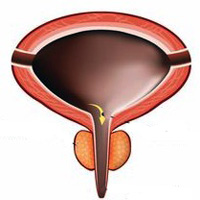Non-invasive diagnosis of under active bladder: A pilot study

Accepted: February 2, 2022
All claims expressed in this article are solely those of the authors and do not necessarily represent those of their affiliated organizations, or those of the publisher, the editors and the reviewers. Any product that may be evaluated in this article or claim that may be made by its manufacturer is not guaranteed or endorsed by the publisher.
Objective: We assessed the efficacy of voiding efficiency (VE) to distinguish between underactive bladder (UB) and bladder outlet obstruction (BO) without using pressure flow studies (PFS).
Materials and methods: in male patients, uroflowmetry and post-void residual (PVR) urine data and subsequent pressure flow studies (PFS) data were examined retrospectively. Bladder outlet obstruction index (BOI) and bladder contractility index (BCI) were calculated from patients' PFS values. Patients with BCI < 100 and BOI < 40 were grouped as UB group and patients with BCI > 100 and BOI > 40 were grouped as BOO group. VE was computed as a percentage of volume voided compared to the pre-void bladder volume.
Results: In total we examined 93 patients, 44 in UB and 49 in BO group. There was no statistically significant difference between the two groups in relation to Qmax value (p = 0.38). However, total voiding time, time to reach the maximum urinary flow rate and voided volume showed statistically significant difference between the two groups (p < 0.001). Average VE was 63.6 + 2.43% and 46.2 + 2.63%) for UB and BO groups respectively and the difference was statistically significant (p < 0.001). UB can be diagnosed with at least 95% sensitivity and 88% specificity in men over age 80.
Conclusions: Non-invasive uroflowmetry and VE measurements were able to differentiate between UB and BOO patients, presenting with identical clinic features, but different findings of PFS.
Chapple CR, Osman NI, Birder L, et al. The underactive bladder: a new clinical concept? Eur Urol. 2015; 68:351-3. DOI: https://doi.org/10.1016/j.eururo.2015.02.030
Thomas AW, Cannon A, Bartlett E, et al.The natural history of lower urinary tract dysfunction in men: minimum 10-year urodynamic follow-up of untreated detrusor underactivity. BJU Int. 2005;96:1295. DOI: https://doi.org/10.1111/j.1464-410X.2005.05891.x
Jeong SJ, Kim HJ, Lee YJ, et al. Prevalence and clinical features of detrusor underactivity among elderly with lower urinary tract symptoms: a comparison between men and women. Korean J Urol. 2012;53:342. DOI: https://doi.org/10.4111/kju.2012.53.5.342
Han DH, Jeong YS, Choo MS, et al. The efficacy of trans urethral resection of the prostate in the patients with weak bladder contractility index. Urology. 2008; 71:657. DOI: https://doi.org/10.1016/j.urology.2007.11.109
Thomas AW, Cannon A, Bartlett E, et al. The natural history of lower urinary tract dysfunction in men: the influence of detrusor underactivity on 23 the outcom eafter trans urethral resection of the prostate with a minimum 10-year urodynamic follow-up. BJU Int. 2004; 93:745. DOI: https://doi.org/10.1111/j.1464-410X.2003.04719.x
Hakenberg OW, Ryall RL, Langlois SL, Marshall VR. The estimation of bladder volume by sonocystography. J Urol. 1983; 130:249-51. DOI: https://doi.org/10.1016/S0022-5347(17)51087-3
Schafer W, Abrams P, Liao L, et al. Good urodynamic practices: uroflowmetry, filling cystometry,and pressure-flow studies. Neurourol Urodyn. 2002; 21:261. DOI: https://doi.org/10.1002/nau.10066
Abrams P. Bladder outlet obstruction index, bladder contractility index and bladder voiding efficiency: three simple indices to define bladder voiding function. BJU Int. 1999; 84:14. DOI: https://doi.org/10.1046/j.1464-410x.1999.00121.x
Tubaro A, La Vecchia C. Uroscreening Study Group. The relation of lower urinary tract symptoms with life style factors and objective measures of benign prostatic enlargementand obstruction:an Italian survey. Eur Urol. 2004;45:767. DOI: https://doi.org/10.1016/j.eururo.2004.01.011
Hotta H, Morrison JF, Sato A, et al. The effects of aging on the rat bladder and its innervation. Jpn J Physiol. 1995;45:823. DOI: https://doi.org/10.2170/jjphysiol.45.823
Taylor JA 3rd, Kuchel GA. Detrusor underactivity: Clinical features and pathogenesis of an underdiagnosed geriatric condition. J Am Geriatr Soc. 2006; 54:1920-32. DOI: https://doi.org/10.1111/j.1532-5415.2006.00917.x
Abrams P, Buzelin JM, Griffiths D, et al. The urodynamic assessment of lower urinary tract symptoms. Proceedings of the 4th International Consultation of Benign Prostatic Hyperplasia (BPH) 1997. Edited by Denis L, Griffiths K, Khoury S, et al. Plymouth: Plymbridge Distributors. 1998; 323-77.
Abrams P, Griffiths D. The assessment of prostatic obstruction from urodynamic measurements and from residual urine. Br J Urol. 1979; 51:129. DOI: https://doi.org/10.1111/j.1464-410X.1979.tb02846.x
Schafer W. Basic principles and clinical application of advanced analysis of bladder voiding function. Urol Clin N Am. 1990; 17:553. DOI: https://doi.org/10.1016/S0094-0143(21)00968-X
Griffiths DJ, vanMastrigt R, Bosch R. Quantification of urethral resistance and bladder function during voiding, to the with special reference to the effects of prostate size reduction on urethral obstruction due to benign prostatic hyperplasia. Neurourol Urodyn. 1989; 8:29. DOI: https://doi.org/10.1002/nau.1930080104
Bosch JLHR, Kranse R, vanMastrigt R, et al Dependence of male voiding efficiency on age, bladder contractility and urethral resistance: development of a voiding efficiency nomogram. J Urol. 1995; 154:190. DOI: https://doi.org/10.1016/S0022-5347(01)67263-X
PAGEPress has chosen to apply the Creative Commons Attribution NonCommercial 4.0 International License (CC BY-NC 4.0) to all manuscripts to be published.


 https://doi.org/10.4081/aiua.2022.1.51
https://doi.org/10.4081/aiua.2022.1.51



